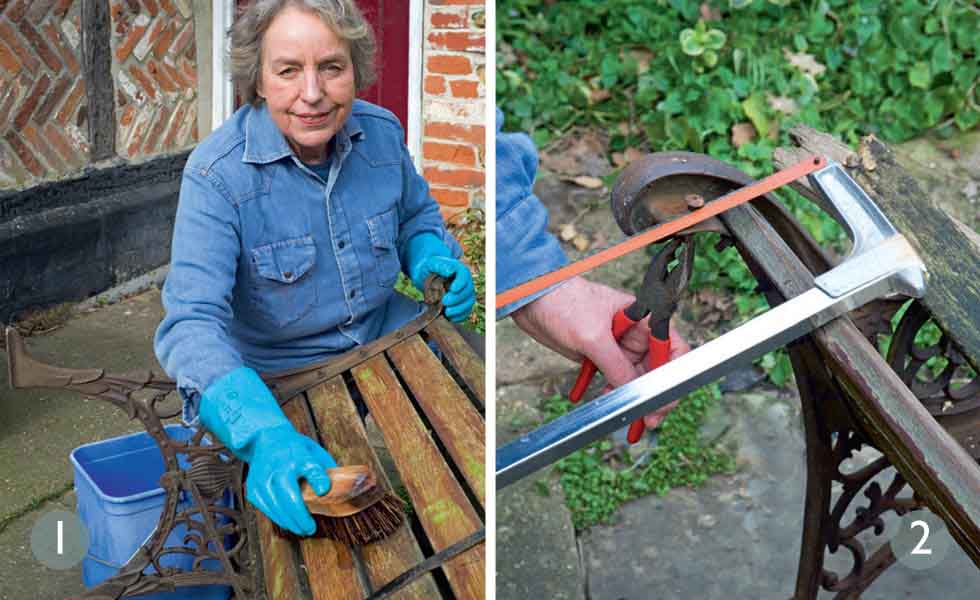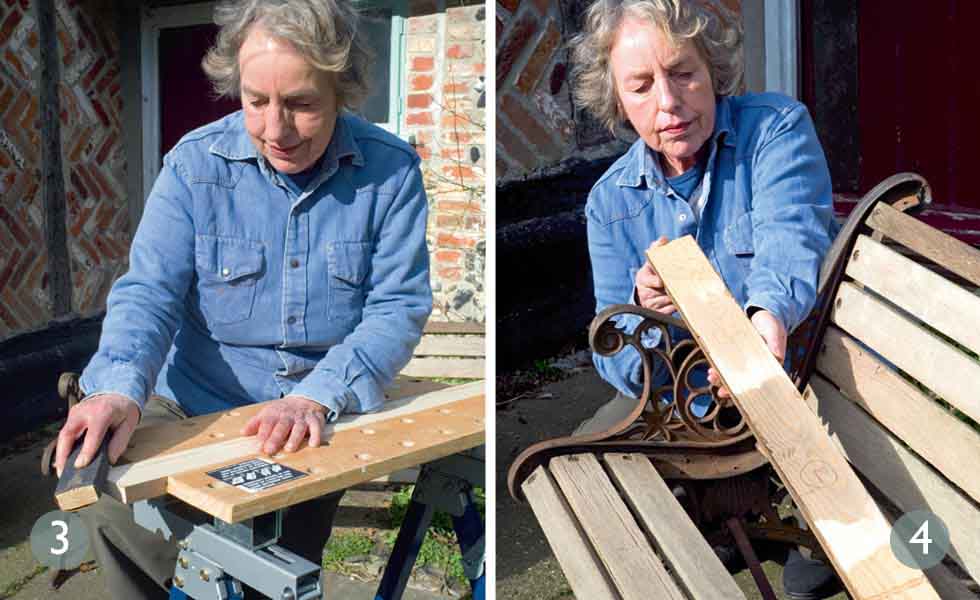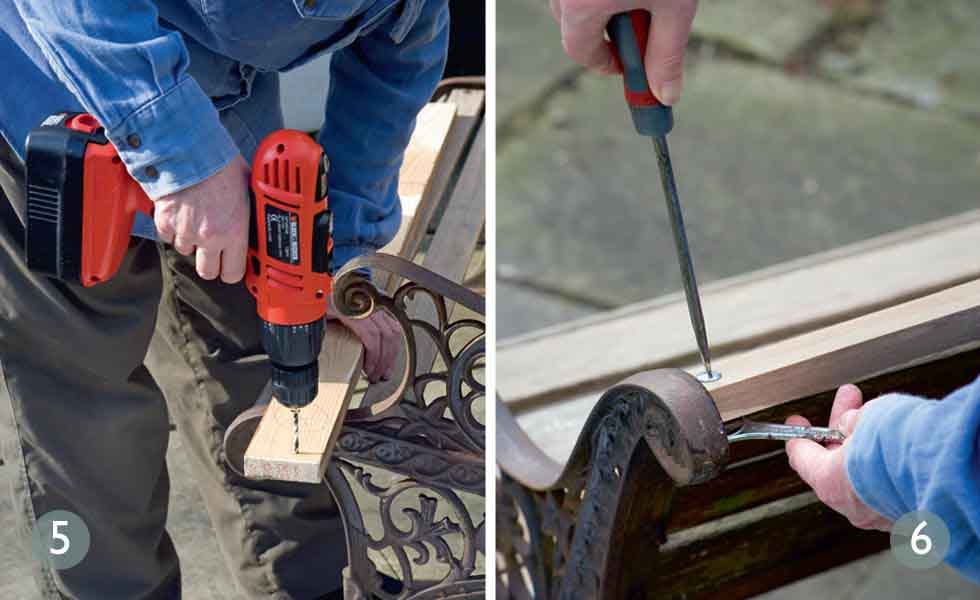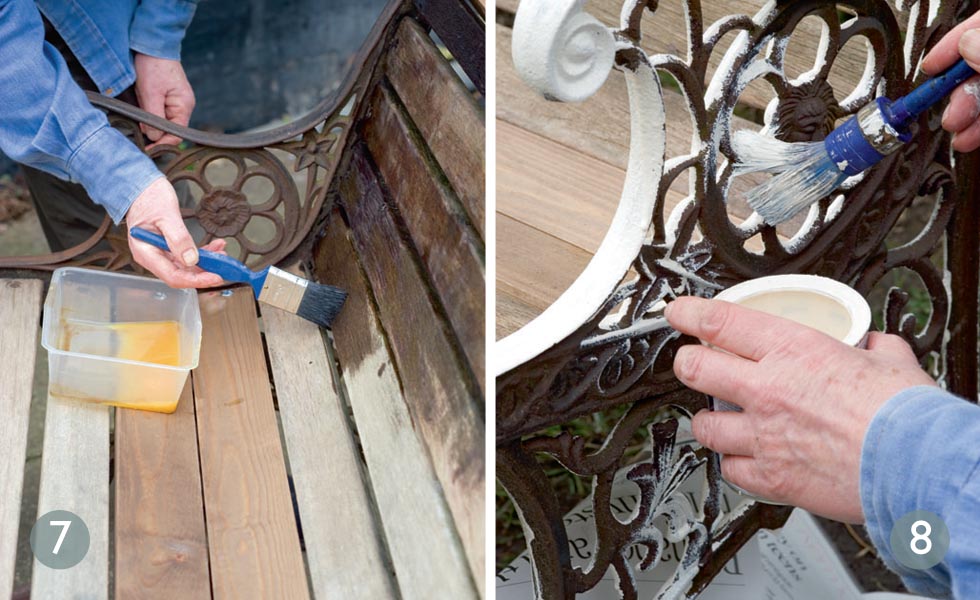How To Repair A Bench Seat
Woods and metallic benches, especially vintage or antiquarian ones, require regular maintenance. The Edwardian cast iron and wood garden bench we are restoring in the step-by-pace guide below had been ignored for far too long. Sitting in obscurity at the end of the garden, it was covered in fallen leaves, moss and algae and some of the wooden slats were rotted beyond salvation.
Caput to our defended garden ideas feature for more inspiration.
You will need:

1. Scrub off algae and dirt
Brush away vegetation with a strong castor. Make full a bucket with hot soapy h2o and requite the bench a good scrub. Rinse with clean water. Once dry, examine the slats to see if any demand to be replaced. Push a screwdriver into softened woods to exam extent of decay. Remove basics and bolts and take off rotten slats.
2. Release jammed basics and bolts
If the nuts and bolts used to fix the wood are rusty, try spraying with release oil and leave overnight. Nevertheless stuck? Find a screwdriver to match the bolt head. Concur in place and give it a sharp accident with a hammer to break through the corrosion. The last resort is to cut through with a hacksaw.

three. Supervene upon rotten wooden slats
Using reclaimed wood to brand new slats is the greenest choice. Source wood at secondhand woods yards, such as the Brighton & Hove Wood Recycling Project (opens in new tab), land auctions or salvage yards. Measure and saw to length, so smooth the cut ends with a sanding block.
4. Tone downwardly the wood surface
New wood makes an obvious repair but wood dye helps blend it in. Use scrap woods or the underside of the slats to test wood stains until you lot observe the closest match. Number each exam patch and wait until they are dry before deciding on the shade.

five. Prepare the new slats
Lay the new planks on the bench. From underneath mark the positions of the bolts. To avoid splitting the wood when fixing it on to the bench, make a pilot hole with a small drill chip. When it merely breaks through the wood, stop drilling and complete the hole from the other side. Echo with a bolt-sized drill bit.
six. Fix the new slats to the demote
Push the bolts through each end of the plank and secure with the nuts. Once all the bolts are correctly positioned, go circular and tighten all of the nuts. Concord the bolt head with a screwdriver and then tighten the nuts with a spanner. Dip each commodities into a little grease to help to go on whatever rust at bay.

7. Employ preservative and Danish oil
Apply a coat of preservative to the wood. When dry, apply Danish oil with a brush. Any surplus should exist wiped off with a rag and then it doesn't congeal and go gummy. Leave at least iv hours and utilize a further two coats with the aforementioned method.
8. Bandbox up the cast fe frame
Use a wire brush or wire wool to remove rust and any remnants of paint. If using all-purpose woods and metal paint, yous will need to begin with a metallic primer followed by an undercoat. Alternatively go for a straight-to-metal pigment. Apply two coats, following instructions on the can for drying times.
Almanac maintenance for your garden bench
- Twice a year, clean woods with warm soapy h2o and apply a coat of Danish oil. This offers some protection from the weather condition and keeps the bench looking skillful.
- Ready metal buffers to the lesser of wooden legs and, if they begin to show signs of disuse, stand each leg in a jar of woods preservative overnight.
- If you have a shed, put your bench within for the winter or give it a scrap of protection nether a plastic embrace.
Where to place your garden demote?
- Practise you prefer to sit in the sun or shade? Check which areas of your garden are in sun or shade at different times of the 24-hour interval. One time you've decided on the perfect location for your garden demote, you'll need to practice a little groundwork.
- Don't just place the bench on the lawn or bloom bed as the legs will be afflicted by the abiding contact with wet basis. Excavate the grass or earth beneath and replace with shingle or place each leg on to a paving slab. This will make mowing easier, as well.
- Apply a spirit level to check the slabs are level – if the bench is permanently used on an uneven surface, information technology can strain and open the joints.
Read more:
- Choose the best garden bench for your space
- How to restore a garden statue
- Revive metallic garden article of furniture
- Maintain original iron railings
Source: https://www.realhomes.com/advice/how-to-restore-a-garden-bench

0 Response to "How To Repair A Bench Seat"
Post a Comment